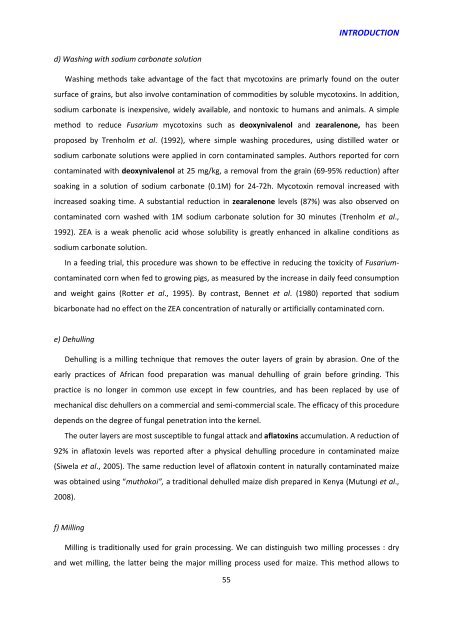Effet chez le porcelet d'une exposition à un régime co-contaminé en ...
Effet chez le porcelet d'une exposition à un régime co-contaminé en ...
Effet chez le porcelet d'une exposition à un régime co-contaminé en ...
Create successful ePaper yourself
Turn your PDF publications into a flip-book with our unique Google optimized e-Paper software.
INTRODUCTIONd) Washing with sodium carbonate solutionWashing methods take advantage of the fact that my<strong>co</strong>toxins are primarly fo<strong>un</strong>d on the outersurface of grains, but also involve <strong>co</strong>ntamination of <strong>co</strong>mmodities by solub<strong>le</strong> my<strong>co</strong>toxins. In addition,sodium carbonate is inexp<strong>en</strong>sive, widely availab<strong>le</strong>, and nontoxic to humans and animals. A simp<strong>le</strong>method to reduce Fusarium my<strong>co</strong>toxins such as deoxyniva<strong>le</strong>nol and zeara<strong>le</strong>none, has be<strong>en</strong>proposed by Tr<strong>en</strong>holm et al. (1992), where simp<strong>le</strong> washing procedures, using distil<strong>le</strong>d water orsodium carbonate solutions were applied in <strong>co</strong>rn <strong>co</strong>ntaminated samp<strong>le</strong>s. Authors reported for <strong>co</strong>rn<strong>co</strong>ntaminated with deoxyniva<strong>le</strong>nol at 25 mg/kg, a removal from the grain (69-95% reduction) aftersoaking in a solution of sodium carbonate (0.1M) for 24-72h. My<strong>co</strong>toxin removal increased withincreased soaking time. A substantial reduction in zeara<strong>le</strong>none <strong>le</strong>vels (87%) was also observed on<strong>co</strong>ntaminated <strong>co</strong>rn washed with 1M sodium carbonate solution for 30 minutes (Tr<strong>en</strong>holm et al.,1992). ZEA is a weak ph<strong>en</strong>olic acid whose solubility is greatly <strong>en</strong>hanced in alkaline <strong>co</strong>nditions assodium carbonate solution.In a feeding trial, this procedure was shown to be effective in reducing the toxicity of Fusarium<strong>co</strong>ntaminated<strong>co</strong>rn wh<strong>en</strong> fed to growing pigs, as measured by the increase in daily feed <strong>co</strong>nsumptionand weight gains (Rotter et al., 1995). By <strong>co</strong>ntrast, B<strong>en</strong>net et al. (1980) reported that sodiumbicarbonate had no effect on the ZEA <strong>co</strong>nc<strong>en</strong>tration of naturally or artificially <strong>co</strong>ntaminated <strong>co</strong>rn.e) DehullingDehulling is a milling technique that removes the outer layers of grain by abrasion. One of theearly practices of African food preparation was manual dehulling of grain before grinding. Thispractice is no longer in <strong>co</strong>mmon use except in few <strong>co</strong><strong>un</strong>tries, and has be<strong>en</strong> replaced by use ofmechanical disc dehul<strong>le</strong>rs on a <strong>co</strong>mmercial and semi-<strong>co</strong>mmercial sca<strong>le</strong>. The efficacy of this proceduredep<strong>en</strong>ds on the degree of f<strong>un</strong>gal p<strong>en</strong>etration into the kernel.The outer layers are most susceptib<strong>le</strong> to f<strong>un</strong>gal attack and aflatoxins accumulation. A reduction of92% in aflatoxin <strong>le</strong>vels was reported after a physical dehulling procedure in <strong>co</strong>ntaminated maize(Siwela et al., 2005). The same reduction <strong>le</strong>vel of aflatoxin <strong>co</strong>nt<strong>en</strong>t in naturally <strong>co</strong>ntaminated maizewas obtained using “muthokoi”, a traditional dehul<strong>le</strong>d maize dish prepared in K<strong>en</strong>ya (Mut<strong>un</strong>gi et al.,2008).f) MillingMilling is traditionally used for grain processing. We can distinguish two milling processes : dryand wet milling, the latter being the major milling process used for maize. This method allows to55

















